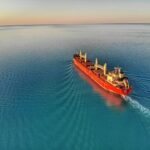Introduction to Marine Renewable Energy

Marine renewable energy (MRE) encompasses technologies that harness the ocean’s kinetic and potential energy for sustainable electricity generation. With growing urgency to decarbonise our energy systems and mitigate climate change, MRE stands as a critical component in a diversified renewable energy portfolio.
Types of Marine Renewable Energy Sources
Diverse MRE resources present unique engineering and environmental considerations:
Tidal Energy: Reliable and governed by lunar cycles, tidal energy offers a predictable power source.
Wave Energy: The dynamic motion of ocean waves holds significant energy potential, driving ongoing innovation in capture technologies.
Offshore Wind Energy: Capitalising on stronger, more consistent winds in open ocean areas, offshore wind facilitates the deployment of larger turbines for increased power output.
Harnessing Tidal Energy
Methods to convert tidal currents and ranges into electricity include:
Tidal Stream Turbines: Functioning similarly to wind turbines, these devices extract energy from moving water bodies in areas with strong tidal currents.
Tidal Barrages: Large dam-like structures built across estuaries or bays, tidal barrages generate power as the tide ebbs and flows.
Tidal Lagoons: Enclosed artificial basins constructed along the coast utilise tidal flows for controlled power generation, potentially reducing environmental impacts compared to traditional barrages.
Capturing Wave Energy
The complexity of wave dynamics drives the development of various capture devices:
Point Absorbers: Floating buoy-like structures convert the vertical motion of waves into usable energy.
Oscillating Water Columns: Partially submerged chambers use wave-driven air pressure fluctuations to turn turbines.
Attenuators: Articulated, multi-segmented devices oriented parallel to wave direction generate power by harnessing the bending motion induced by waves.
The Promise of Offshore Wind Energy
Offshore wind energy offers numerous advantages over onshore installations, including access to higher average wind speeds, reduced visual and land-use conflicts, and the ability to install significantly larger turbines.
Environmental Impact of Marine Renewable Energy
MRE deployment necessitates careful consideration of potential ecological effects. Concerns include habitat modification, impacts on marine wildlife through noise or collision, and alterations to oceanographic processes. Thorough environmental impact assessments and mitigation strategies are integral to responsible development.
Case Studies of Marine Renewable Energy Projects
Successful MRE projects across the globe demonstrate the growing viability of these technologies:
The MeyGen tidal array in Scotland boasts the world’s most powerful tidal turbines, supplying thousands of homes.
The Aguçadoura Wave Farm in Portugal pioneered the use of attenuator devices for wave energy conversion.
The United Kingdom leads in offshore wind capacity, with vast farms like Hornsea Project One generating gigawatts of clean energy.
Policy and Regulation in Marine Renewable Energy
A robust regulatory framework is essential for responsible MRE development. This includes comprehensive permitting processes, environmental impact assessments, and potential policy incentives to promote the growth of the sector.
The Economics of Marine Renewable Energy
MRE technologies currently face higher capital costs compared to mature renewable sources. However, technological advancements, economies of scale, and the declining cost of storage solutions are improving economic competitiveness. A long-term perspective that accounts for avoided fossil fuel costs and reduced carbon emissions is crucial for a balanced assessment.
Challenges and Opportunities in Marine Renewable Energy
The MRE sector must overcome challenges such as the harsh marine environment, the need for cost-effective technologies, and public acceptance. Simultaneously, it presents substantial opportunities for innovation, job creation, and the decarbonisation of the global energy mix.
Community Engagement and Stakeholder Consultation
Effective stakeholder engagement throughout project lifecycles is essential. Proactive communication and collaboration with local communities, fishing industries, and environmental groups fosters trust and facilitates the identification of solutions to minimise potential negative impacts.
The Future of Marine Renewable Energy
The future of MRE is characterised by rapid innovation. Emerging concepts include floating offshore wind platforms, hybrid devices harnessing multiple energy sources, and technologies optimised for integration with energy storage solutions. As these technologies mature and costs decline, MRE is poised to play a vital role in achieving a sustainable energy future.
Facts and Stats
Tidal Energy
Tidal energy is generated by harnessing the kinetic energy of tidal currents and the potential energy from the difference in water levels between high and low tides. According to the International Energy Agency (IEA), tidal energy has the potential to generate about 800 terawatt-hours (TWh) of electricity annually worldwide. Countries with strong tidal energy potential include the UK, Canada, France, China, and South Korea.
Wave Energy
Wave energy is derived from the motion of ocean waves. Devices such as wave buoys, oscillating water columns, and point absorbers capture this energy. The Global Wave and Tidal Energy Market is projected to reach a value of over $10 billion by 2027, with a compound annual growth rate (CAGR) of around 29%. Scotland, Portugal, Australia, and the United States are among the leading countries investing in wave energy research and development.
Ocean Thermal Energy Conversion (OTEC)
OTEC utilises the temperature difference between warm surface water and cold deep water to generate electricity. The potential for OTEC is vast, with estimates suggesting it could theoretically produce over 10,000 terawatt-hours of electricity annually worldwide. Despite its immense potential, OTEC is still in the early stages of development, with only a few experimental plants in operation.
Ocean Current Energy
Ocean current energy involves extracting kinetic energy from ocean currents, such as the Gulf Stream and the Kuroshio Current. The United States Department of Energy estimates that ocean currents along the U.S. coastline could generate up to 1,400 terawatt-hours of electricity per year. Challenges in harnessing ocean current energy include technological complexity, environmental concerns, and high upfront costs.
Salinity Gradient Energy
Salinity gradient energy, also known as osmotic or blue energy, is generated by the difference in salt concentration between freshwater and seawater. According to the European Commission, global salinity gradient energy potential is estimated at around 1,600 TWh per year. Research and development efforts are underway to improve the efficiency and scalability of salinity gradient energy technologies.
Floating Wind Farms
While not strictly a marine renewable energy source, floating wind farms utilise wind turbines anchored to the seabed in deep waters, where traditional fixed-bottom turbines are not feasible.
The Global Wind Energy Council predicts that floating wind capacity could reach 70 gigawatts (GW) by 2040, up from just a few megawatts today. Countries with significant potential for floating wind energy include Norway, Portugal, Japan, and the United States (particularly the West Coast and Hawaii).
Resources















